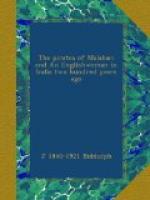[1] They were issued at the rate of sixty-five for
a rupee; before long,
their value was reduced to
seventy-two for a rupee, at which price
they were much in request,
and the Governor reported that he expected
to coin sixteen tons of them
yearly.
[2] In October, 1713, the Bombay Council decided that
the Xeraphims, being
much debased with copper and
other alloy, their recognized value
should in future be half a
rupee, or two Laris and forty reis. The
Xeraphim was a Goa coin, originally
worth less than one and sixpence.
The name, according to Yule,
was a corruption of the Arabic ashrafi.
[3] The year before, the Godolphin had escaped
from an Angrian fleet,
after a two days’ encounter
within sight of Bombay.
[4] The records are silent as to the Defiance,
but it is mentioned by
Downing, who says that, instead
of doing his duty, the captain made
the best of his way to Bombay.
The story seems to be borne out by a
faded letter from the captain
to the Directors, appealing against
dismissal from the service.
[5] The name is now given to the group of islands
to which Bourbon and
Mauritius belong. At
that time it generally applied to Bourbon, and
especially to St. Paul’s
Bay, which was a favourite place of call for
ships to water at.
[6] According to some accounts, the first settlement
was a few years
earlier, but the dates of
the early travellers are very unreliable.
Hamilton says that a present
was sent in 1685 to the Queen; “A
beautiful young English gentleman
had the honour to present it to her
black Majesty; and as soon
as the Queen saw him, she fell in love with
him, and next day made proposals
of marriage to him, but he modestly
refused so great an honour
however, to please her Majesty, he staid at
court a month or two and satisfied
her so well that when he left her
court she made him some presents.”
[7] Bruce.
[8] This is the reason given by Bruce for Brabourne
leaving Anjengo, but
the death of Brabourne’s
wife, in 1704, probably had a good deal to do
with his leaving the place.
Her tomb still exists.
[9] Tranqueira (Port.), a palisade.
[10] Meaning sequin: the origin of the modern Anglo-Indianism, chick.’
[11] The father of Robert Orme, the historian, who was born at Anjengo.




